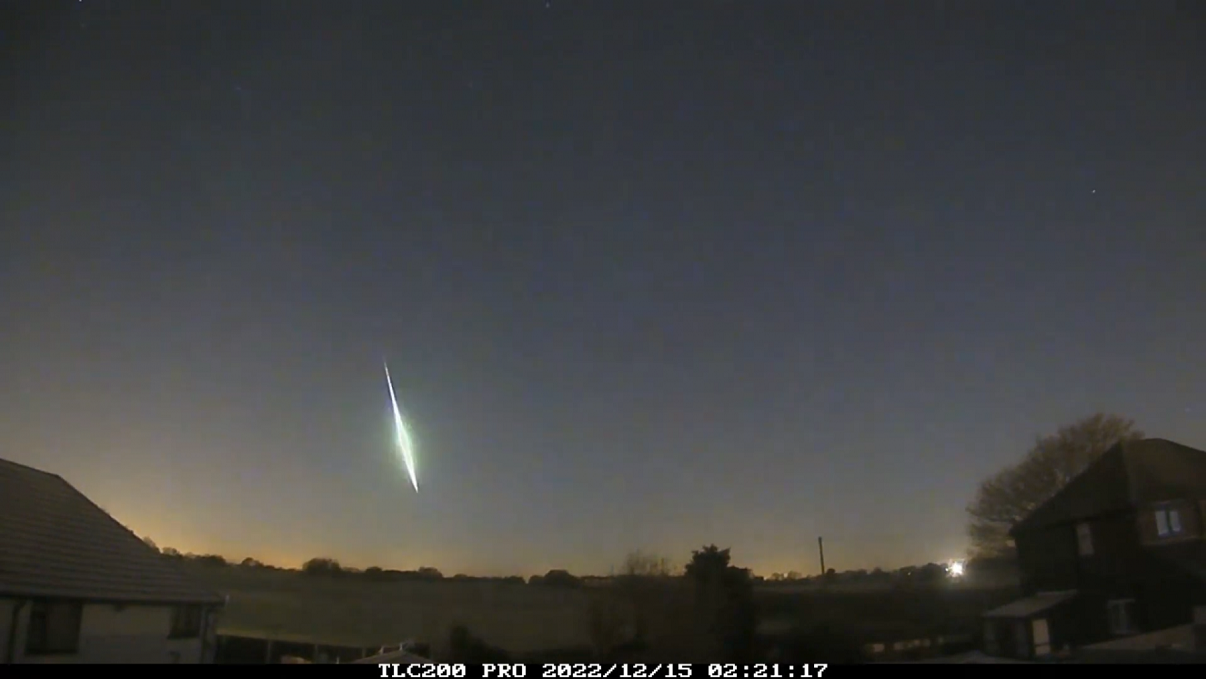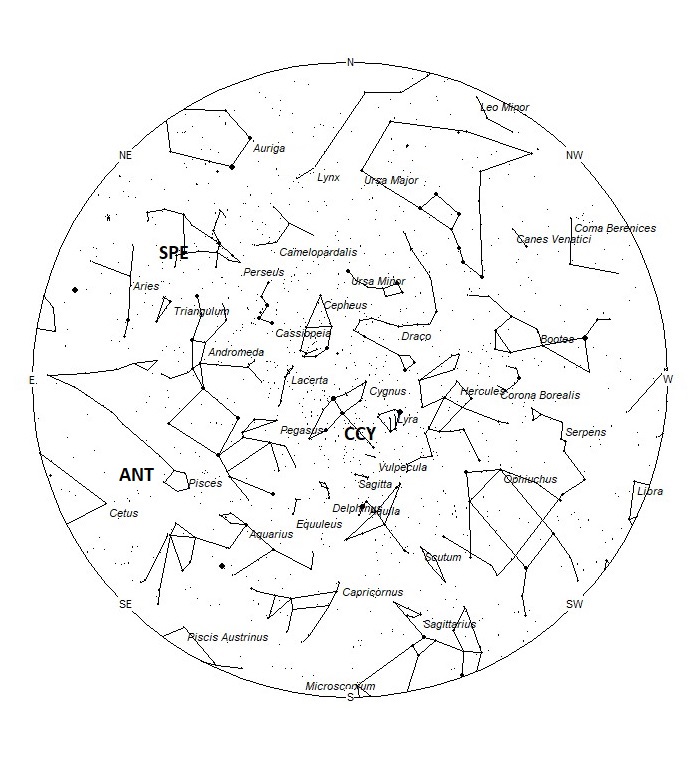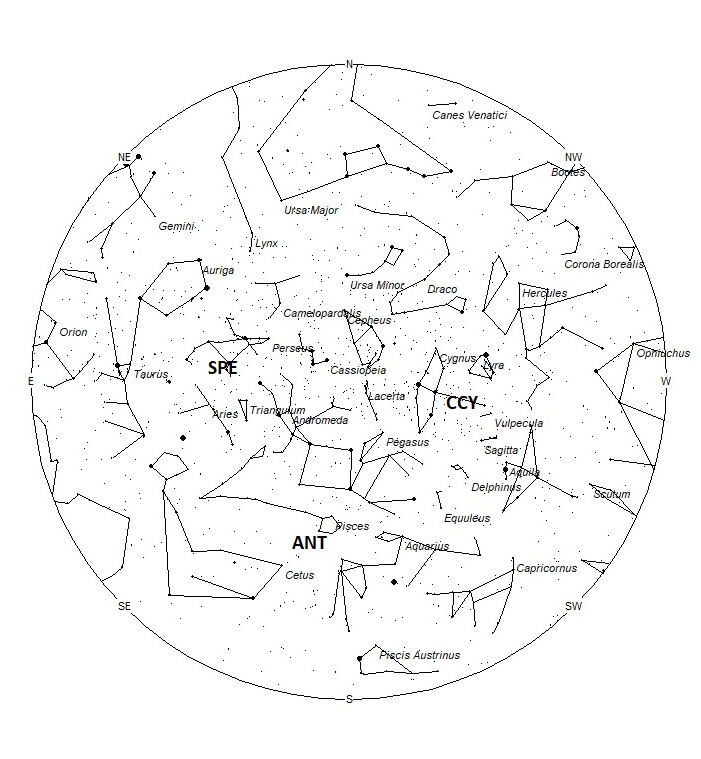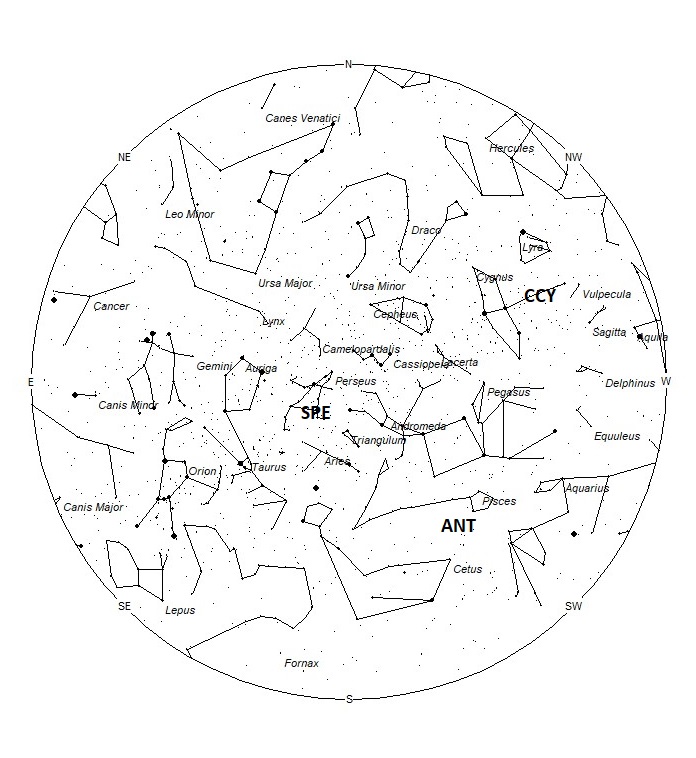 Kevin Bradshaw captured this bright fireball from Irlam, England on December 15, 2022 at 0221 GMT. Although no stars are visible in the photograph, we can assume this fireball was a member of the Geminid shower as the date was only one night past maximum activity. ©Kevin Bradshaw
Kevin Bradshaw captured this bright fireball from Irlam, England on December 15, 2022 at 0221 GMT. Although no stars are visible in the photograph, we can assume this fireball was a member of the Geminid shower as the date was only one night past maximum activity. ©Kevin BradshawDuring this period, the moon reaches its new phase on Friday September 15th. On that date the moon will be located near the sun and will be invisible at night. This weekend the waning crescent moon will rise during the early morning hours but should not be much of a nuisance as long as you keep it out of your field of view. The estimated total hourly rates for evening observers this week should be near 3 as seen from mid-northern latitudes (45N) and 2 as seen from tropical southern locations (25S) For morning observers, the estimated total hourly rates should be near 13 as seen from mid-northern latitudes (45N) and 8 as seen from tropical southern locations (25S). The actual rates seen will also depend on factors such as personal light and motion perception, local weather conditions, alertness, and experience in watching meteor activity. Note that the hourly rates listed below are estimates as viewed from dark sky sites away from urban light sources. Observers viewing from urban areas will see less activity as only the brighter meteors will be visible from such locations.
The radiant (the area of the sky where meteors appear to shoot from) positions and rates listed below are exact for Saturday night/Sunday morning September 9/10. These positions do not change greatly day to day so the listed coordinates may be used during this entire period. Most star atlases (available at science stores and planetariums) will provide maps with grid lines of the celestial coordinates so that you may find out exactly where these positions are located in the sky. I have also included charts of the sky that display the radiant positions for evening, midnight, and morning. The center of each chart is the sky directly overhead at the appropriate hour. These charts are oriented for facing south but can be used for any direction by rotating the charts to the desired direction. A planisphere or computer planetarium program is also useful in showing the sky at any time of night on any date of the year. Activity from each radiant is best seen when it is positioned highest in the sky, either due north or south along the meridian, depending on your latitude. Radiants that rise after midnight will not reach their highest point in the sky until daylight. For these radiants, it is best to view them during the last few hours before dawn. It must be remembered that meteor activity is rarely seen at its radiant position. Rather they shoot outwards from the radiant, so it is best to center your field of view so that the radiant lies toward the edge and not the center. Viewing there will allow you to easily trace the path of each meteor back to the radiant (if it is a shower member) or in another direction if it is sporadic. Meteor activity is not seen from radiants that are located far below the horizon. The positions below are listed in a west to east manner in order of right ascension (celestial longitude). The positions listed first are located further west therefore are accessible earlier in the night while those listed further down the list rise later in the night.
These sources of meteoric activity are expected to be active this week.
.
The chi Cygnids (CCY) were discovered on the night of 14/15 September 2015, when a weak outburst of meteors occurred where none had been observed before. Since then, little activity has been detected until August of 2020, when another mini outburst of possible CCY activity occurred south of the normal radiant between the constellations of Delphinus and Aquila. Some astronomers believe this early appearance may herald another return of the CCY’s from their normal radiant in southern Cygnus. Nothing unusual occurred in September 2020, but activity from this source should be monitored, nonetheless. The most probable dates of this occurring would be on the nights from September 13-15. At that time the radiant should be located near 20:00 (300) +31, a position 3 degrees southeast of the variable star chi Cygni. An easier method of locating the radiant would be to draw an imaginary line from the bright stars Albireo (beta Cygni) to Aljanah (epsilon Cygni). The radiant lies just short of the half-way point of this line. These meteors can be seen all night long but are best seen near 22:00 Local Summer Time (LST) when the radiant lies nearly overhead as seen from the northern hemisphere. Rates are expected to be low but anyone seeing any of these meteors should report them to the International Meteor Organization on an online visual meteor report form. With an entry velocity of 19 km/sec., the average meteor from this source would be of very slow velocity. Unfortunately, these meteors are not well seen from the southern hemisphere as Cygnus does not rise high into the sky from those locations.
The large Anthelion (ANT) radiant is currently centered at 00:00 (000) +01. This position lies in western Pisces, 6 degrees south of the 4th magnitude star known as omega Piscium. This radiant is best placed near 02:00 LST when it lies on the meridian and is highest in the southern sky. Rates at this time should be near 2 per hour no matter your location. With an entry velocity of 30 km/sec., the average Anthelion meteor would be of medium-slow velocity.
The September epsilon Perseids (SPE) are active from September 2-23, with maximum activity occurring on the 10th. The current position of the radiant lies at 03:10 (048) +40. This area of the sky lies in southwestern Perseus, 1 degree south of the famous eclipsing variable star known as Algol (beta Persei). To best see these meteors, face half-way up toward the east during the last hour prior to dawn. Rates at this time may be near 1 per hour as seen from the northern hemisphere and less than 1 as seen from south of the equator. There have been outbursts from this source in the past, but none are predicted for this year. With an entry velocity of 64 km/sec., the average meteor would be of swift velocity.
As seen from the mid-northern hemisphere (45N) one would expect to see approximately 10 sporadic meteors per hour during the last hour before dawn as seen from rural observing sites. Evening rates would be near 3 per hour. As seen from the tropical southern latitudes (25S), morning rates would be near 6 per hour as seen from rural observing sites and 2 per hour during the evening hours.
The list below offers the information in tabular form. Rates and positions are exact for Saturday night/Sunday morning except where noted in the shower descriptions.
| SHOWER | DATE OF MAXIMUM ACTIVITY |
CELESTIAL POSITION | ENTRY VELOCITY | CULMINATION | HOURLY RATE | CLASS |
| RA (RA in Deg.) DEC | Km/Sec | Local Summer Time | North-South | |||
| chi Cygnids (CCY) | Sep 14 | 20:00 (300) +31 | 19 | 22:00 | <1 – <1 | IV |
| Anthelion (ANT) | – | 00:00 (000) +01 | 30 | 02:00 | 2 – 2 | II |
| Sept. epsilon Perseids (SPE) | Sep 10 | 03:10 (048) +40 | 64 | 05:00 | 1 – <1 | II |
Class Explanation: A scale to group meteor showers by their intensity:
- Class I: the strongest annual showers with Zenith Hourly Rates normally ten or better.
- Class II: reliable minor showers with ZHR’s normally two to ten.
- Class III: showers that do not provide annual activity. These showers are rarely active yet have the potential to produce a major display on occasion.
- Class IV: weak minor showers with ZHR’s rarely exceeding two. The study of these showers is best left to experienced observers who use plotting and angular velocity estimates to determine shower association. These weak showers are also good targets for video and photographic work. Observers with less experience are urged to limit their shower associations to showers with a rating of I to III.







 You saw something bright and fast? Like a huge shooting star? Report it: it may be a fireball.
You saw something bright and fast? Like a huge shooting star? Report it: it may be a fireball.  You counted meteors last night? Share your results with us!
You counted meteors last night? Share your results with us!  You took a photo of a meteor or fireball? You have a screenshot of your cam? Share it with us!
You took a photo of a meteor or fireball? You have a screenshot of your cam? Share it with us!  You caught a meteor or fireball on video? Share your video with us!
You caught a meteor or fireball on video? Share your video with us!